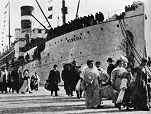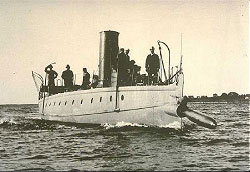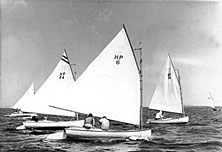 | ||||||||||
 |
History and CultureModern EraImmigration:Between 1911 and 1934 vessels of the Fabre Line, a French steamship company brought over immigrants from southern and eastern Europe via Narragansett Bay to a port in Providence. The bulk of the passengers were from Italy and Portugal. From May 1911 to July 1914, the Fabre line carried more than 30,000 passengers to Providence. In the year 1921, the Fabre Line carried almost 14,000 westbound passengers, this was the best year for the Fabre Line at the Narragansett Bay port.
Trade/Commerce:During the Prohibition Era, Narragansett Bay provided excellent opportunities for rum-runners to transport their contraband. With its three entrances, the Bay allowed many opportunities for contraband to be left onshore and then sold. Tanker traffic was Narragansett Bay's leading commercial operation and petroleum products refined in other areas used the head of the Bay for local storage. Military:The Bay was used as a training ground for fighting ships. Freighters arrived and departed Narragansett Bay during the early 20th century. Pilots dive-bombed the bay on practice runs. Fisherman worked around the buoymarked torpedo-testing zones. All the forts at the mouth of the Bay were manned, there were more than 10,000 men stationed in the forts.
The Navy has maintained its role in the Bay and during the mid 20th century was the biggest economic force and provided many jobs for the states civilians. The Bay still offers an area for many Navy programs that go on today. Recreation:Narragansett Bay has always been filled with pleasure boats, but over the last 100 years, hundreds of boats have turned into thousands. After the World War II, recreational boating became big. With the invention of the beetle cat boat, the Bay was used for recreation and sailing training.
There are more than 400 miles of coastline in Rhode Island and more than 100 fresh or saltwater beaches. Beaches along the Narragansett Bay provide a recreation ground for tourists and locals alike. Over 12 million people visit Narragansett Bay each year, many of whom come to experience many of the beautiful beaches it has to offer. 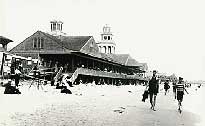 Narragansett Pier Beach ~ 1905 (Courtesy of South Kingston Public Library, Peacedale, RI) (Click for larger version). Rhode Island can be considered one of the sailing capitals of the world. Rhode Island has been host to the America's Cup races for more than fifty years. SCUBA diving in the Bay has also become popular due to the many prime sites the bay has to offer. What started out during the 19th century, continues into the modern era. Narragansett Bay also provides a prime location for vacation homes. Along many of the beaches, extravagant homes have been built and the population increases in many coastal communities during the summer months. Natural Resources:The Bay has and continues to provide employment for fishermen and food for families. The quohaug fishery, the crab, lobster and conch pot fishermen continued to work throughout the war. Scalloping was also popular and oystermen continued to tend to their beds in the upper Bay. Today, the quohaug fishery is thriving. Recently, over 3000 acres of the Bay have been newly opened for shellfishing. Over three and a half million pounds of quahog meat was brought into the docks in one year, with a value of almost 16 million dollars. Natural Disasters:Narragansett Bay has been through its share of natural disasters. One of the biggest was the Great New England Hurricane of 1938. It was one of the most destructive and powerful storms ever to strike southern New England. Narragansett Bay took the worst hit. A storm surge of 12 to 15 feet destroyed many coastal communities and the tides increased rapidly. 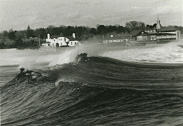 Narragansett Beach (Courtesy of South Kingston Public Library, Peacedale, RI) (Click for larger version). Two more hurricanes swept through Narragansett Bay during the mid 20th century. Hurricane Carol came along in 1954 and southern coastal communities were hard hit. A year later in August of 1955, Hurricane Diane brought the worst flooding in Rhode Island. After this storm, a hurricane barrier was built. Top of Page
|
|||||||||
